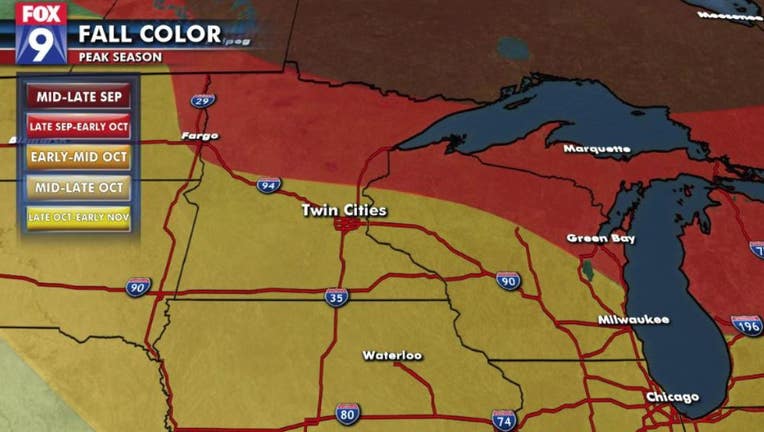Bring on the fall colors

(FOX 9) - Here we are again, heading into one of the prettiest times of the year.
While this signals an end to the warm season, it could not go out in a better way. I’m sure you’ve noticed the spots of color here and there, but the bright yellows, oranges, and reds should really pop in the coming days as we pass our recent warm spell and head for cooler conditions next week. This should lead northern Minnesota right into peak season, which isn’t all that far away.
On average, the northern third of the state will see peak fall color before we even make it to October. For the middle third, and much of the lower third really, it’s the first or second week of October when colors peak.
But, our falls appear to be getting warmer as of late, as evidenced by the last several days around here with temperatures into the 80s. So once again, our fall colors may be delayed by a few days. if not more.
So, why do leaves change color in the fall?

We all know that leaves are green in the summer, turn a different color in the fall, then fall off the trees typically before the first snowflakes fly. That is a fact we all learn at a very young age and many of us look forward to them every year because it can be one spectacular sight.
Just like everything else, trees need food and water to survive. The way they get their food is through a process called photosynthesis where they use sunlight to convert water and carbon dioxide into sugar; their basic food source. In order to do this, the leaves need a chemical called chlorophyll. Anything in the environment that’s green has this chemical compound in it. When chlorophyll is exposed to any light source, it only reflects the wavelength on the part of the visual spectrum. Therefore, we see the color green.
Now, there are two other components in leaves (and many other things in nature): Carotenoids and anthocyanins. These two compounds make up the rest of the leaves, but are in far less quantity than the chlorophyll. When fall approaches and the leaves stop their production of chlorophyll, the carotenoids and anthocyanins become visible before the leaves fall from their perch atop a tree and begin to decompose.
Leaves that contain carotenoids turn the bright yellows, golds, and oranges that we see in the fall. These can also be found in many foods we eat that are the same colors like corn and carrots just to name a few. But, those colors are always present in these foods because there is no presence of chlorophyll. Anthocyanins are found in leaves that turn different shades of red. These compounds are more rare in our environment, which is why many trees do not turn shades of red and only grow in certain areas. Just like carotenoids, anthocyanins can be found in other naturally growing foods like apples, cranberries, strawberries and more.
Good luck looking at your fruits and vegetables the same way again. It’s okay, you’ll forget about it because you’ll be too distracted from the beautiful fall colors. Enjoy!

